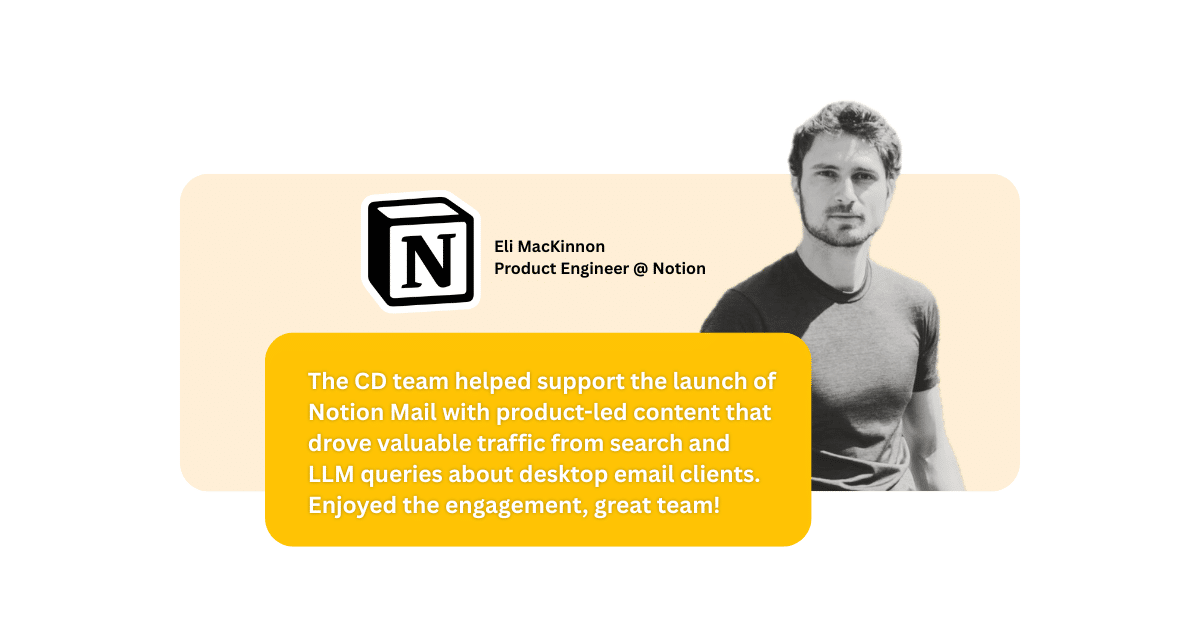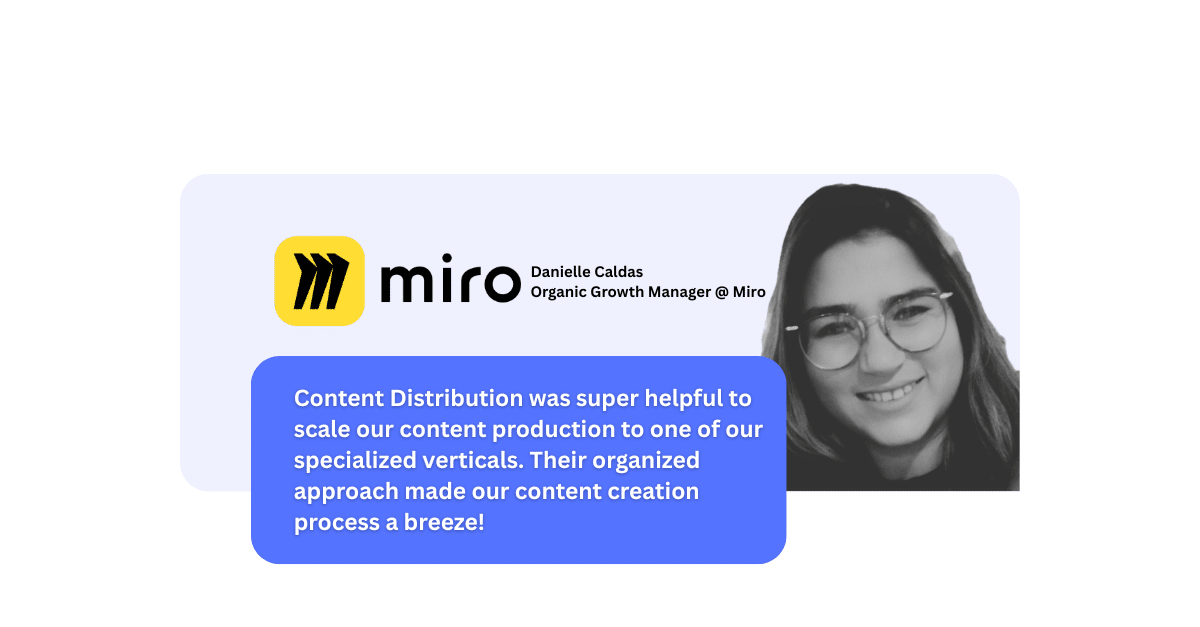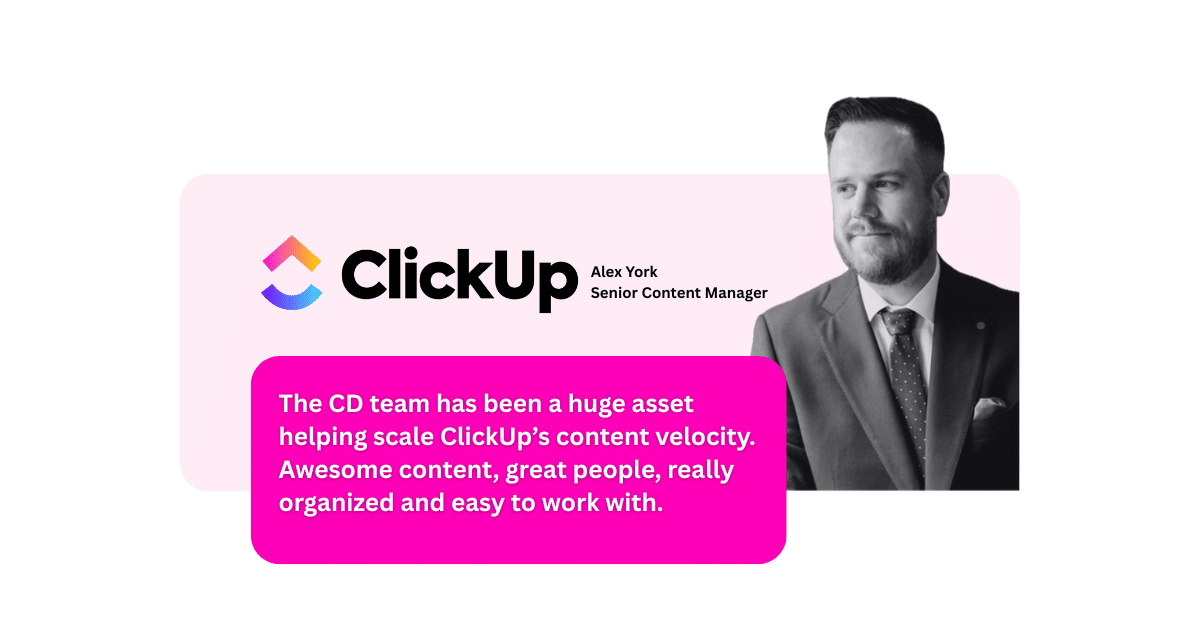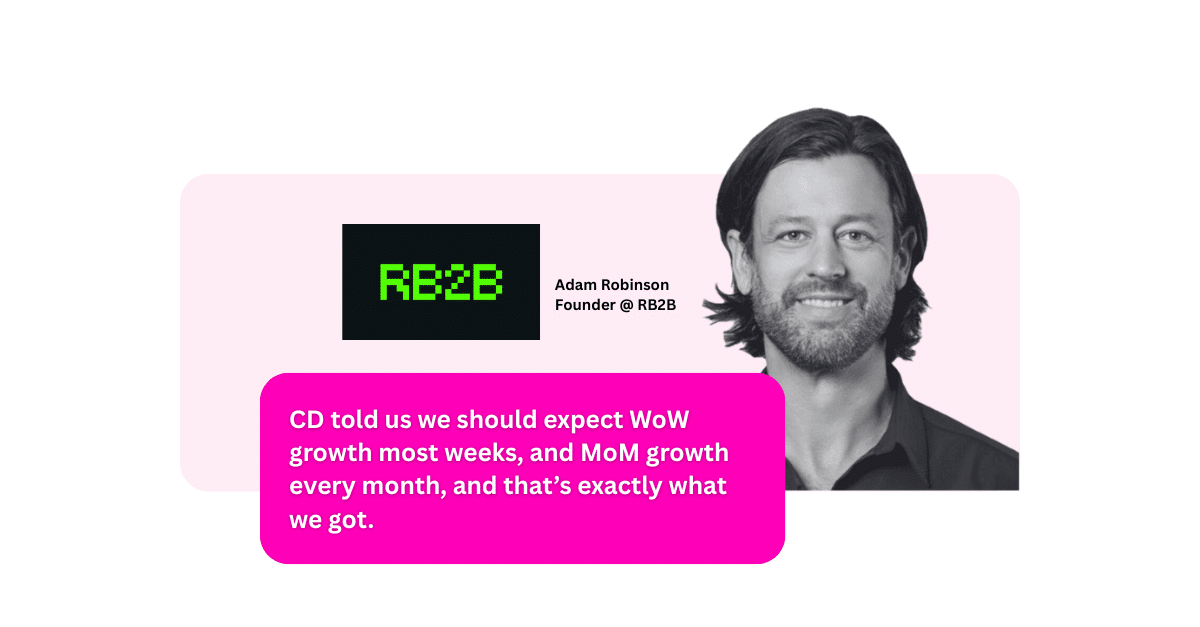

How Any Writer Can Write SEO Content
Content Distribution publishes 400+ pages of content per month.
Our clients specifically seek to work with us because of our skill set in generating an audience through organic search.
We hire our writers because they’re good writers, not because they know anything about SEO.
Usually, when writers say they know SEO, what they mean is they’ve read some stuff and watched some videos.
What they never mean is, they have a consistent process to ensure the content they write ranks again and again and again.
When we look at their portfolio, none of their work is generating traffic from search.
But that’s OK.
So, how do we take great writers and enable each of them to create content that ranks every time?
We do it the same way that we publish 200+ pages of content per month.
We do it with processes, documentation, and systems.
If you don’t want to see:
- Proof that all you need to have to rank is excellent content, not backlinks or technical SEO
- Awesome Facebook groups to recruit great writers from
- How much you need to pay
- How to keep your writers happy and productive
And you only want the process document, then scroll to the end

What is SEO content writing?
We believe that Google’s #1 goal is to show the most relevant, highest quality content for any given search query every time.
Why do we believe that’s Google’s #1 goal?
- Alphabet generates 95% of its revenue from Google Adwords
- Google Adwords makes 120 billion dollars a year
- A one percent loss in market share represents over a billion dollars in high margin revenue.
- To maintain their brand as the #1 search engine, they need to provide better search results than everyone else
We didn’t just make up this philosophy of organic search distribution.
We’ve published hundreds of pages of content across the projects we’ve worked on, and have over 65,000 first page keywords.
Not everything ranks and not everything ranks fast, but when we publish vast amounts of highly relevant, high-quality content, it has never failed to work.
High-Quality Content
Google isn’t an AI, and it can’t intuitively identify quality content as we can.
Instead, Google relies on heuristics.
We believe the strongest heuristics of content quality are user engagement metrics, and how they compare to those for other pages that Google could show for a given keyword.
- Bounce rate
- Time on site
- Pages visited
- Overall site engagement (button clicks, CTAs, etc.)
If you closely monitor your rankings, it’s common to see your page pop on and off the first page before ultimately settling somewhere.
That is Google testing and stack-ranking your page based on user engagement metrics.
And through trillions of searches, Google has developed a pretty good idea of the characteristics of high-quality content.
Think about it this way.
Imagine we showed you two pieces of content on a topic about which you knew nothing.
Say, quantum physics, or quantum computing.
The first piece is 1,000 words in one giant paragraph.
The second piece of content is 3,000 words and has:
- A table of contents
- Bullet Points
- Lists
- Tables
- Embedded YouTube videos
- Pictures
- Important sentences in bold
- Internal links to relevant content
- External links to authoritative websites
Even if you didn’t understand the topic, which would you assume is the better piece of content?
You’d pick the one with a ton of structured data.
So, when Google crawls your site, and it finds a ton of structured data like lists, tables, and bullet points, it assumes that the quality of your content is high.
It then tests you on the first page quicker than it would without these characteristics of high-quality content.
Relevance
Being relevant to a given search is just as crucial as having high-quality content.
Every day, people create content that will never rank nor attract eyeballs because Google doesn’t believe it’s relevant to a given keyword.
You only have so much real estate to drive relevance.
- URL
- Meta title
- Meta description
- H1
- H2s
- H3s
- Internal links
Being relevant doesn’t mean using the same keyword again and again and again across your available real estate.
It means using variations of the keyword for which you want to rank.
In this article, my core keyword is ‘seo content writer.’
But I’ve also optimized the content for variations of this core keyword:
- SEO content writing
- SEO content writers
- Writing SEO content
- Writing web content for SEO
You have to be careful when you pick the variations because if you choose the wrong variations, you might not rank for anything.
It’s very counterintuitive, and today doing keyword research is more of an art than a science.
If you write a post about ‘the best LinkedIn headlines & profiles,’ your post will neither rank for ‘LinkedIn headlines’ nor for ‘LinkedIn profiles.’
Go ahead and Google each term.
The pages ranking on the first page are optimized for just one of those keywords.
LinkedIn profiles

LinkedIn headlines

They use the:
- URL
- Meta title
- Meta description
- H1s
- H2s
- H3s
To drive the relevance for one keyword or the other, not both.
Being relevant at scale
Today, people choose their keyword research using a ‘gut feeling.’

Over 20 SEO professionals replied to this post and gave their opinion.
Not a single one based their opinion on data. They all gave advice ‘from their gut.’

It takes a lot of time to figure this out. It’s more of an art than a science.
We weren’t satisfied with the keyword research process being an uncertain art, which takes a significant amount of time for every piece of content produced.
We turned keyword research into a science that’s based on data, not on our gut. That way, we can generate a year-long content calendar in less than an hour.
How it works:
- Import as many as 10,000 relevant keywords to your business
- The tool crawls Google and
- Figures out which keywords can rank together
- Then groups the keywords that can rank together into discrete content topics
- With the exact variations to use in each piece
Here’s what that looks like:

Notice how ‘hiring writers’ and ‘hire content writers’ are separate?
Look at the variations. I see one keyword that doesn’t include ‘content’ in the ‘hire content writers’ keyword group.
Google both keywords, and you’ll see that each of the different search results contain different pages optimized for one keyword or the other.
Comparing each keyword against other keywords to get this right is tedious to the point where it’s simply not done.
So, people guess. When they screw up, they don’t rank for either keyword.
When more relevant, higher quality content isn’t enough, and why you should make it anyway
Content may not be enough if you’re operating in:
- Gambling
- Finance
- Dating
- Healthcare
- Cancer lawsuits
But for most businesses, and most industries, content is enough.
That isn’t to say that backlinks don’t help, they do.
A lack of backlinks has never stopped us from ranking well before, but having a lot of backlinks makes our job easier.
Even when backlinks are necessary, highly relevant, high-quality content requires fewer backlinks to rank than less relevant, lower-quality content.
Below are examples showing the impact of content that is more relevant and higher quality than that of the competition.
In every example, you’ll note our page has less domain strength and fewer backlinks than the competition that we are beating.
Examples:
- Web content
- E-commerce content
- B2B SaaS content
- Mobile Apps content
Writing web content for SEO

Doggypedia is America’s favorite website to learn about different mixed breed dogs, with over 200 unique articles.
This keyword represents 23,000 searches a month.
Here’s a little context about what the numbers mean.
We only highlighted the columns you care about.
- DR
- Backlinks
DR stands for Domain Rating. It is a proprietary metric that measures the strength of a domain based on the backlink profile.
YouTube, Facebook, and Google are all 100s.
The site you created yesterday is a 0.
It’s not a metric that Google uses. It’s a metric created by Ahrefs, the tool from which we took all of the screenshots that you’ll see here.
Even though Google does not use it, it’s still a very useful metric to understand how powerful a given domain is.
Not only does Doggypedia’s domain have the weakest backlink profile as indicated by the DR (domain rating) score, but of the nine other pages, only 1 page has fewer backlinks.
And it’s not just that keyword. It’s hundreds of them, 504 position-one keywords, and thousands of keywords on the 1st page.

SEO Writing for E-Commerce
Hobanco is an outdoor e-commerce brand selling knives. We built and sold this website a few years ago.
Quick note: If you want to learn how to leverage sponsored YouTube videos as an acquisition channel for your e-commerce store, you need to read this post. Otherwise, keep reading.
When someone searches for [state knife laws], that searcher generally already owns a knife or is looking to purchase one. Our research showed that people who buy knives to carry around have a lot of knives.

Of the ten 1st page search results, Hobanco has the second-lowest DR, and the second-lowest number of backlinks – yet it outranks pages on stronger domains with many more backlinks.
By the way, that featured snippet means we appear as shown below.

Well-structured content gets you lots of featured snippets.
This site hasn’t been touched since April 2018, and yet it grows month after month after month.
That’s the power of great content.

B2B SaaS SEO Content
BrandChamp.io helps e-commerce brands create and scale ambassador programs to thousands of participants.
It’s a seriously impressive product but lacked awareness of the buyer’s life cycle.
Each customer is worth anywhere from $3,000 per year to tens of thousands per year.

This blog post alone might be worth $100,000.
But it’s not alone.
The brands that are the most successful with search don’t create one piece of content and hope it ranks. They create a piece of content for every opportunity across the buyer’s life cycle.

And again

Learn more B2B SEO tactics we’re using right now to outrank bigger brands with larger budgets
Writing SEO Content B2C SaaS companies
DoNotPay is a San Francisco based startup backed by Peter Thiel that has created the world’s first AI robot lawyer and has helped over 200,000 people dispute and beat their parking tickets (among a bunch of other cool things).

Remember what I said above about how backlinks aren’t necessary, just helpful?
This is just one of the hundreds of pages DoNotPay has page 1 keywords for.
When you create a lot of high-quality content, you can stop paying attention to individual rankings, and you can focus on:
- Do we have more keywords on the first page this week than we did last week?
- Did we have more organic search traffic this month than we did last month?
Calculate your ROI using our SEO ROI formula (Google Sheet)
17 months into this campaign DoNotPay has grown from approximately zero to 500,000 organic search visitors per month.

This isn’t a fluke.
Before this, we took CampusReel.org to 166,000+ organic search visitors per month, in about 12 months.

Learn why we crush B2C SaaS SEO projects

Hiring writers (that don’t know SEO)
If you’re like the businesses we work with, your core team is best equipped to create the highest quality content, but they have the least amount of time to write it.
Writing the type of content you need to have to rank isn’t easy.
At a minimum, it’s going to take a few hours.
And if you find the time to write one page here and there, you’re not going to achieve the outcome you wanted from organic search.
So you need to hire writers to write your content for you.
Before we give you the template to turn any content writer into an SEO content writer, let’s help you find awesome writers with whom to work.
Pay your writers per word, not hourly
Paying your writers by the hour is ineffective.
They won’t be motivated to write.
The truth hurts. Every person I’ve met who pays their writers hourly gets less content for the dollar than those who pay writers per word.
For most of the content we create, we pay our writers a minimum of five cents per word, but it can go as high as ten cents per word for our enterprise SaaS projects in highly technical industries.
You won’t find the quality you’re looking for with the reliability you need for less than five cents per word.
Hiring good, affordable writers on auto-pilot

Here’s the deal.
Just like the #1 lever for faster SEO results is publishing more content.
The #1 lever for hiring better writers is evaluating and testing more writing candidates.
That’s it.
The more writers you evaluate and test, the more likely you are to find the right mix of quality, affordability and capacity.

Check out the metrics on this hiring cycle:
- 174 candidates
- 80 invited to take our pre-hire writing test
- 55 submitted a completed test
- 26 writers passed the test
We use Workello to filter through hundreds of candidates to identify and hire the top 1% in just a few minutes.

Here’s how it works.
- Post your job ad on Reddit, LinkedIn, Facebook, ProBlogger, etc
- Watch candidates stream into your hiring dashboard
- Send pre-hire writing tests to your best candidates
- Sitback, relax and wait for candidates to take your test
- Hire the top 1%
Everything in Workello is pre-written and pre-optimized so you can start accepting writers into your hiring funnel in 90 seconds.
Here are some hiring guides to get you up and running ASAP:
- Get 200+ writers in the next 72 hours
- Hiring writers for hard content (Dev Ops, SaaS, legal, martech, etc)
- Outsource job posts to a VA
- Why writer marketplaces are broken
If you want to produce more than eight pages a month, you need to hire multiple SEO content writers
We have yet to meet a writer who can create enough content for one project.
We’ve tried. They said that they could produce 3,000 words per day and handle 20 blog posts a month. They couldn’t. Not even close.
Writer’s brains began to fry, especially if they’re writing about a subject that they need to research relatively more.
When your writer doesn’t deliver, they set you back.
You then need to source, evaluate, and test another writer.
Good freelance SEO writers have a lot of clients.
And they’re not going to drop their reliable, consistent clients to write your content ‘real quick.’ They’re going to schedule you in.
So if you assign the content on a Monday, you should expect a full week to receive the first draft.
And another week after that for revisions on the feedback you provide.
If you’re producing a lot of content, you can’t risk your production schedule by giving a single writer too much work.
We hire enough writers for each project, where each writer only needs to write one article per week.
At most, two per week, and only if they’ve consistently met deadlines over the past several months.
Treat your SEO content writers like real people
Don’t treat your content writers like virtual assistants, treat them as valued members of your core team.
Good content writers for five cents a word have a higher ROI than Google stock.
Creating a lot of good quality content is expensive, and it takes time.
But it takes a lot more time if you can’t retain your writers and need to spend more time than necessary sourcing, evaluating, and testing new content writers.
Gordana, Content Distribution’s Content Manager, was a professional writer for seven years before stepping into a content management role with us. According to her, the two most important things you can do to keep your writers happy are:
- Pay them on-time, as in immediately after approving their final draft, or at a minimum pay them bi-weekly
- Create outlines that help them precisely understand what you want, minimizing revisions
There’s just one more thing
Alright, I know you had to read a lot to get to what you really wanted: the template that turns any writer into a great SEO content writer.
I want you to be able to use the template below as effectively as possible.
To do that, you had to read everything above.
There’s just one more thing, and to see it, I want your email address.
Don’t worry.
I’m not going to spam you.
I’m going to hook you up with the keyword research processes I use to:
- Turn any writer into an SEO content writer
- Rank over 65,000 keywords on the first page
- Generate millions of views
Then use the Ahrefs keyword research process until you receive my data-driven keyword research process via email.

Our best content
Want to learn how we’ve grown 4 websites from approximately zero to 100,000 visitors per month, with the biggest one doing 500,000 in just 17 months?

We share it all.
- How we crush B2B SaaS SEO
- Brand Jacking (ranking for your competitor’s brands)
- How we crush B2C SaaS SEO
- Forecasting SEO ROI
- How Google actually works (based on 65,000 page 1 keywords)
- How to turn any writer into an SEO content writer
- How to rank without backlinks
- How to find and hire the highest quality, most affordable writers on the internet
- The #1 lever to get the fastest SEO results
- The greatest SEO case study of 2020: 0 to 479,000 monthly organic in 16 months



